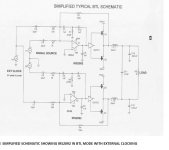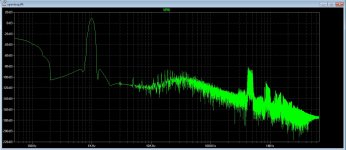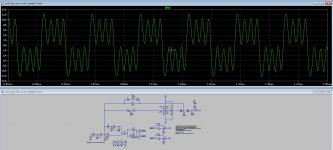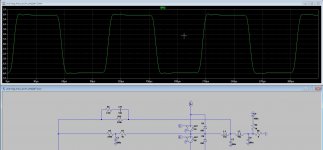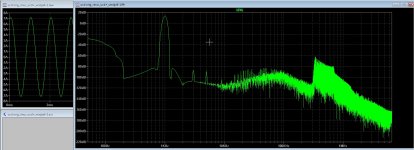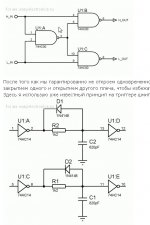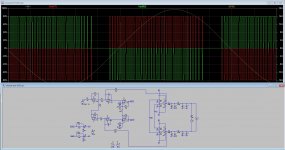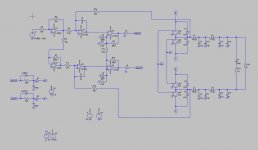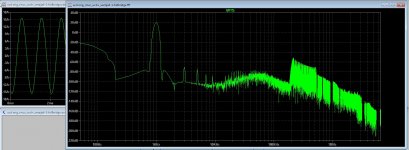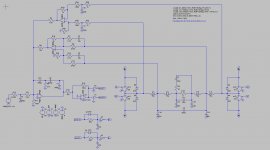If we all go buy ready made electronics then this forum stop to excist, included the fun, it is just the challence to experiment and build electronics and learn.
For as quality the tube mosfet hybrids do still sound the best, I have not yet build the class d, but maybe a open loop with air coil and oil capacitor and see what happens. Need to make a lineair as possible sawtooth, maybe digital programmed.
regards'
Can you please elaborate in more detail on which type of hybrid tube mosfet amps you refer to ?
But between feedback and speaker there is additional LC filter? Why not combining those two filters into single filter?
The additional low pass do nothing more then remove extra HF, the real demodulation lowpass is only the first coil, but when I do use a higher HF then these can be removed, 24dB filtering however remove much more switching noise when using lower frequency, there is contribute on much more cleaner rise and fall times and as such less deadtime and lower HD.
I think I go for 12dB and higher frequency because the parts get's better these days.
"Digitally programmed" ?
It had been many years since I played with generating a sawtooth digitally, but I remember the implemention had issues with the required clock frequency compared with the audio sample frequency.
So, how do you plan to make a digitally programmed sawtooth?
regards dyiMartin
..
For as quality the tube mosfet hybrids do still sound the best, I have not yet build the class d, but maybe a open loop with air coil and oil capacitor and see what happens. Need to make a lineair as possible sawtooth, maybe digital programmed.
regards'
It had been many years since I played with generating a sawtooth digitally, but I remember the implemention had issues with the required clock frequency compared with the audio sample frequency.
So, how do you plan to make a digitally programmed sawtooth?
regards dyiMartin
Ha, good one, you tooI too wasn't highly impressed with TPA3116 which was what led me to TDA8932 - Cheap TPA3118D2 boards, modding them and everything that comes with it
Thanks for the link - I've got a much better idea about exploiting these amps now. Pretty much everything that could be tried was tried in that and the TDA8932 thread
It had been many years since I played with generating a sawtooth digitally, but I remember the implemention had issues with the required clock frequency compared with the audio sample frequency.
So, how do you plan to make a digitally programmed sawtooth?
regards dyiMartin
Modern controller chips can go high enough for making a sawtooth, like the digital signal generators do, I remember still a table who I did program in a now old memory chip, that was for microstepping a stepmotor.
I do not now if we can program it very lineair, high quality digital signal generators can go easely to 1 Mhz with a pic, the sawtooth generator stays outside the D amp in the sense that it act as a normal sawtooth generator.
I like the idea of a low hd class d open loop, where the low pass is air coil and cap is in oil or other fidelity type, it needs to be liniair, maybe tune it with paralleling some.
The air coil is not that big with use of 60 Khz -3dB point but is inherent lineair keeps impedance lower then with a core?..
regards
Not to change the subject but, I've had a Sure 32512 powering woofers. Every few minutes it emits an electronic sound like an electric motor cycling off/on. Any ideas what this might be.
Motorboot sounds are because of oscillations in a amplifier, a old fenomenum seen by tube amps, because of bad earth connections, do all connectionw to earth to one point, preferebly between the supply caps, and then on the case there.
If it is a stereo version and the amps are class D then you need to sync them together, differents is carrier freqquentie can cause sounds you can hear.
Other way is set the carrier of one amp 50 Khz higher to prevent side effects of carrier who mix and the difference signal is into hearable earea.
regards
Attachments
I have try now a combination of things like a extra integrator, capacitor current feedback and voltage feedback.
I get quite low distortions, even with a dead time 250nS I get -80 dB with 4 amp output current.
regards
I get quite low distortions, even with a dead time 250nS I get -80 dB with 4 amp output current.
regards
Attachments
I have try now a combination of things like a extra integrator, capacitor current feedback and voltage feedback.
I get quite low distortions, even with a dead time 250nS I get -80 dB with 4 amp output current.
regards
This is related to the latest schematics ?
This is related to the latest schematics ?
This one, double feedback, voltage, the current is not yet very stable, but if quite faster regulation. Fase shifts are the big problem there, also with voltage the low pass poles do shift making things more complicated, it can be done, but needs more electronics.
I get however on 60 Khz a harmonic who I think is from the simulation itself, maybe in the parts models things are cause.
regards
Attachments
As you see I get very low distortions, the square test is unsuccesfull when I use post feedback as the dominant one, with the tuning of both feedback we can get a nice square test.
See some more pictures, after tune the feedback lines I see that the prefeedback do make a nice square, including the lowpass making it worse, after put in a little network with resistor and 12 PpF capacitor the peaks are gone, but do slow down the speed of the amp, the fastest speed is when use only prefeedback, so I do try that with a air coil and oil capacitor, both high quality, size is not important with a high end class d, and see what happens.
Current feedback I did try looks like work better when a 0.01 ohm resistor is between amp and null of the supply, amplify that give a nice triangle who can included in the feebback loop, not tryed that yet,
regards
See some more pictures, after tune the feedback lines I see that the prefeedback do make a nice square, including the lowpass making it worse, after put in a little network with resistor and 12 PpF capacitor the peaks are gone, but do slow down the speed of the amp, the fastest speed is when use only prefeedback, so I do try that with a air coil and oil capacitor, both high quality, size is not important with a high end class d, and see what happens.
Current feedback I did try looks like work better when a 0.01 ohm resistor is between amp and null of the supply, amplify that give a nice triangle who can included in the feebback loop, not tryed that yet,
regards
Attachments
Last edited:
This one, double feedback, voltage, the current is not yet very stable, but if quite faster regulation. Fase shifts are the big problem there, also with voltage the low pass poles do shift making things more complicated, it can be done, but needs more electronics.
I get however on 60 Khz a harmonic who I think is from the simulation itself, maybe in the parts models things are cause.
regards
I am missing model, it seems you are using OPA134 ? It is slow audio op amp, try faster op amp?
Why about adding transistor network to shut down poles if when signal is too strong, to prevent unstability?
Last edited:
I am missing model, it seems you are using OPA134 ? It is slow audio op amp, try faster op amp?
Why about adding transistor network to shut down poles if when signal is too strong, to prevent unstability?
You can use LT1722 also for sim, the opa627 also is fast enough for input opamp.
LT1722 is in your ltspice.
a AGC is possible yes, but two diodes antiparalell and good setup feedback will do, use a series resistor for soft clipping, this is enough, just make enough power output so you never reach diode clipping exept with small accidents?.
OPA134 is 8 Mhz, 20 V/us opamp, so quite fast and very good sounding ones also, the OPA627 is best, but expensive.
Has anyone tested the newer GaN output devices for linearity vs the older parts?
I did not, but these are interesting, like low nC. It has ball solder so very low ringing.
I have play with a BD modulator UCD, self osc.
I get quite shoot through's so I do something wrong, maybe I need some more info about these, it is quite a nice idea, even usable with buck converter like output, act as a class ab, small pulses injection I have seen, making it a bi version bd.
someone here can advice me why I get such shoot through, I do see both negative and positive are in line, making it short circuit, in paper I see both a shifted 180 degrees so it do not make trouble.
regards/
Attachments
I can not really help you, since I do not have the experience required. But in German DIY audio forums there is a guy, Saarmichel, (he is also a member here, though, not very active), who has built a lot of Class-D amps (he built tube-amps before). He has put together a list of his subjective findings. You can find it over here. The only thing, that changed is, that he now has a new #1, which is being referenced here. Since you are from Holland I guess, that your German may be better than my Netherlandish ;-) I would especially recommend the last thread, I have mentioned. I take the freedom to quote and translate his list of Class-D amplifiers, he built:Now, there is a single change to the list: The Hypex UcD2K has been replaced by the Sure AA-AB32512. However, there is one caveat. People are uncertain as of it is really the AB32512. While this has been the module people ordered, it seems, that Sure is delivering the AA-AB32313 instead. The model-number on the mainboard implies this. He also mentioned, that in order to achieve the best sound, he had to use either his self-made PSU or the Meanwell HLG-320-36A. When he used a Meanwell HRP-600-48 the sound wasn't to his satisfaction. So, (his) dream-combo seems to be the Sure AA-AB32313 + Meanwell HLG-320-36A atm. That's the one I am going to use for an IA, I just need to settle on a pre-stage before that.
I am aware, that this list is not giving you the technical information, you asked for, but it may give some limited direction.
Has Saarmichel updated this list since first posed?
I did not, but these are interesting, like low nC. It has ball solder so very low ringing.
I have play with a BD modulator UCD, self osc.
I get quite shoot through's so I do something wrong, maybe I need some more info about these, it is quite a nice idea, even usable with buck converter like output, act as a class ab, small pulses injection I have seen, making it a bi version bd.
someone here can advice me why I get such shoot through, I do see both negative and positive are in line, making it short circuit, in paper I see both a shifted 180 degrees so it do not make trouble.
regards/
Someone? I try this and get not what I want, like the BD modulation scheme as in pic two and lot shoot through. Need the 1 Khz modulation input a offset? like minus for the lower comparator and plus for the above one.
I thought this is not complicated, it is not but sim not oke. Some help welcome.'I read some papers about this and the buck converter system looks nice.
regards
- Home
- Amplifiers
- Class D
- What Class-D amp give best sound?
